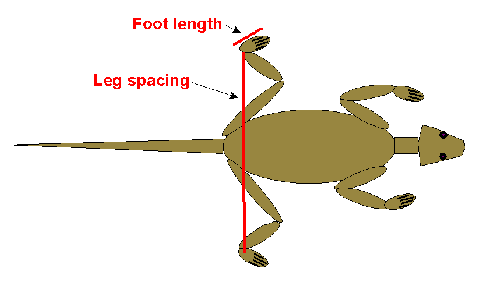POSTURE INDEX: We can solve this
problem of whether bipedal dinosaurs had a sprawling or erect posture by finding the value
of a parameter which we can call an animal's "posture index". The plan would be to calculate
the posture index of a dilophosaur using the trackway painted on the floor of the corridor
adjacent to Rm 4152, and to use the result to assess the stance of this dinosaur. The whole
operation depends on the fact that tetrapod sprawlers have much more widely spaced feet than
tetrapods with an erect posture (refer to the sketch on the previous page if necessary).
We will define posture index as:
Posture Index = (leg spacing)/(foot
length)
where leg spacing is the distance between
the rear feet measured across the body; and foot length is the toe to heel length of a rear
foot. The sketch below shows how to make these measurements.

To reach our goal, we need to calculate posture index for the corridor dilophosaur, and
for a modern sprawling and erect tetrapod. We need posture indices for the modern animals
to provide a framework in which to evaluate dinosaur posture indices. The idea is to
compare the dilophosaur posture index value to values for modern tetrapods in order to
see whether the dilophosaur figure falls closer to that for a sprawler or to that for an
erect animal.
We will do this on page 3, starting with a modern sprawler.











